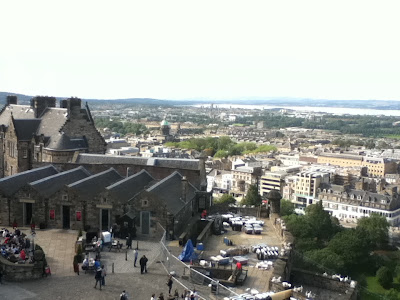Taking a short train ride down to the the end of the Firth of Forth, last week-end, Denise and I were treated to the view of a feat of engineering and workmanship that is as unique as it is impressive: The Falkirk Wheel.
It was Saturday morning, so we wanted to go somewhere. As we have done in the past, we took our #3 bus to Waverly Station in Edinburgh and looked for a destination. Looking up at the 'big board' a train was leaving for Falkirk in 10 minutes. We could go to Falkirk, round trip, for 7 pound each. I had read about the Falkirk Wheel as being something to see, but I wasn't really sure exactly what it was. Denise was game, so we purchased the tickets and off we went.
There are two major canals that were built in the heart of Scotland to enhance transport of goods before the time of highways and rail-lines.
The first, the "Forth and Clyde Canal" opened in 1790 and allowed ships to sail the 35 miles between the Clyde at Glasgow to the Forth at Grangemouth. En route they negotiated 40 locks and 32 swing bridges. This effectively connected the east and west coasts of Scotland.
 |
| A view of the Clyde and Forth Canal running through Falkirk and a Lock and Dam |
 |
| Lock and Dams running down the mouth of the Firth of Forth (translated: Fourth Bay) |
The second, the "Union Canal" opened in 1822. It started in Edinburgh and followed a contour at 73m above sea level for some 30 lock-free miles through the coalfields it was designed to serve to Falkirk.
At Falkirk the two canals were linked together by a ladder of 11 locks that allowed boats on the Forth and Clyde Canal to climb the 35m to the level of the Union Canal. These 11 locks fell out of use as the trains became a more economical way to transport goods, and the land where they were became roads, housing developments, and was otherwise used for communities.
However, in the late 1990's people saw the value of these canals as a good place to live along, and tourism grew up in the form of leisure travel along the canals. The desire to re-connect the two canals was there, but how to do it? The land where the original connection had been made was now cut up and paved over.
Enter the "Millennium Link" project. This ambitious project would re-furbish the canals and the lock and dams for passage. But still, how to make the connection?
The solution is the Falkirk Wheel. Boats approaching from the higher Union Canal now use a new length of waterway before descending through two locks. They then progress through a new 168m long tunnel that emerges at the start of a 104m concrete aqueduct. The far end of this opens directly into the upper of the two "gondolas" of the Falkirk Wheel.
The wheel then rotates, and having descended, what is now the lower gondola opens out into a 100m circular basin whose landscaping carefully conceals its origins as an open cast pit. On one side of this is the beautifully curved structure of the visitor centre. One final lock at the far end of the basin lowers boats to the level of the Forth and Clyde Canal.
Pictures may help here:
 |
| Blue colored tour boat going into gondola that holds as much water as an Olympic size swimming pool. |
 |
| Cool Eh? |
If you want to learn more, you can got to the website, where I got the details for this posting:
For you teachers out there, the following website has material to make lessons in history, math, physics, and mechanical engineering:
http://www.thefalkirkwheel.co.uk/education
After seeing the wheel actually turn (5 minutes for the full cycle), we walked the 3 miles to the center of town along the canal, and had some tea and cake at one of the many tea houses along the main drag. (That's what people do here on a Saturday afternoon.)
By late afternoon we caught the train back to Edinburgh, then caught our now very familiar #3 bus to Dalkieth.
It was a great way to spend a Saturday.
After seeing the wheel actually turn (5 minutes for the full cycle), we walked the 3 miles to the center of town along the canal, and had some tea and cake at one of the many tea houses along the main drag. (That's what people do here on a Saturday afternoon.)
By late afternoon we caught the train back to Edinburgh, then caught our now very familiar #3 bus to Dalkieth.
It was a great way to spend a Saturday.

































